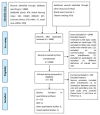The Effectiveness of Shared Care in Cancer Survivors-A Systematic Review
- PMID: 30483035
- PMCID: PMC6199565
- DOI: 10.5334/ijic.3954
The Effectiveness of Shared Care in Cancer Survivors-A Systematic Review
Abstract
Objectives: To determine whether the shared care model during the follow-up of cancer survivors is effective in terms of patient-reported outcomes, clinical outcomes, and continuity of care.
Methods: Using systematic review methods, studies were searched from six electronic databases-MEDLINE (n = 474), British Nursing Index (n = 320), CINAHL (n = 437), Cochrane Library (n = 370), HMIC (n = 77), and Social Care Online (n = 210). The review considered all health-related outcomes that evaluated the effectiveness of shared care for cancer survivors.
Results: Eight randomised controlled trials and three descriptive papers were identified. The results showed the likelihood of similar effectiveness between shared care and usual care in terms of quality of life, mental health outcomes, unmet needs, and clinical outcomes in cancer survivorship. The reviewed studies indicated that shared care overall is highly acceptable to cancer survivors and primary care practitioners, and shared care might be cheaper than usual care.
Conclusions: The results from this review suggest that the patient satisfaction of shared care is higher than usual care, and the effectiveness of shared care is similar to usual care in cancer survivorship. Interventions that formally involve primary care and improve the communication between primary care and hospital care could support the PCPs in the follow-up.
Keywords: cancer; follow-up; shared care; survivors.
Similar articles
-
SCORE: Shared care of Colorectal cancer survivors: protocol for a randomised controlled trial.Trials. 2017 Oct 30;18(1):506. doi: 10.1186/s13063-017-2245-4. Trials. 2017. PMID: 29084595 Free PMC article. Clinical Trial.
-
Promoting and supporting self-management for adults living in the community with physical chronic illness: A systematic review of the effectiveness and meaningfulness of the patient-practitioner encounter.JBI Libr Syst Rev. 2009;7(13):492-582. doi: 10.11124/01938924-200907130-00001. JBI Libr Syst Rev. 2009. PMID: 27819974
-
Systematic reviews of the effectiveness of day care for people with severe mental disorders: (1) acute day hospital versus admission; (2) vocational rehabilitation; (3) day hospital versus outpatient care.Health Technol Assess. 2001;5(21):1-75. doi: 10.3310/hta5210. Health Technol Assess. 2001. PMID: 11532238 Review.
-
Factors influencing the translation of shared cancer follow-up care into clinical practice: a systematic review.BMJ Open. 2022 Aug 29;12(8):e055460. doi: 10.1136/bmjopen-2021-055460. BMJ Open. 2022. PMID: 36038175 Free PMC article.
-
Is immediate imaging important in managing low back pain?J Athl Train. 2011 Jan-Feb;46(1):99-102. doi: 10.4085/1062-6050-46.1.99. J Athl Train. 2011. PMID: 21214357 Free PMC article.
Cited by
-
Moving the Translational Needle in Breast Cancer Survivorship: Connecting Intervention Research to Clinical Practice.J Clin Oncol. 2022 Jul 1;40(19):2069-2073. doi: 10.1200/JCO.22.00174. Epub 2022 Apr 19. J Clin Oncol. 2022. PMID: 35439031 Free PMC article. No abstract available.
-
Cancer prevention, risk reduction, and control: opportunities for the next decade of health care delivery research.Transl Behav Med. 2021 Nov 30;11(11):1989-1997. doi: 10.1093/tbm/ibab109. Transl Behav Med. 2021. PMID: 34850934 Free PMC article.
-
Roles and recommendations from primary care physicians towards managing low-risk breast cancer survivors in a shared-care model with specialists in Singapore-a qualitative study.Fam Pract. 2020 Sep 5;37(4):547-553. doi: 10.1093/fampra/cmaa009. Fam Pract. 2020. PMID: 32030402 Free PMC article.
-
Continuity of Cancer Care: Female Participants' Report of Healthcare Experiences After Conclusion of Primary Treatment.Curr Oncol. 2025 Jul 11;32(7):399. doi: 10.3390/curroncol32070399. Curr Oncol. 2025. PMID: 40710209 Free PMC article.
-
Late-effect awareness and follow-up of cancer in general practice.Scand J Prim Health Care. 2022 Sep;40(3):360-369. doi: 10.1080/02813432.2022.2139457. Epub 2022 Nov 15. Scand J Prim Health Care. 2022. PMID: 36380478 Free PMC article.
References
LinkOut - more resources
Full Text Sources


